Your entryway sets the tone for your entire home, and I know how much the right rug can change that space.
When the rug fits just right, your entry feels warm, balanced, and welcoming while keeping dirt and moisture from spreading across your floors. The tricky part is figuring out which size will actually work best.
That’s why I put together this entryway rug size guide for you. I’ll walk you through measuring your space, choosing the right proportions, and finding materials that match your lifestyle.
Along the way, I’ll share practical tips, maintenance advice, and common mistakes to avoid so you can create an entryway that feels both inviting and functional.
How to Measure Your Entryway for Rug Size
With the correct size, your rug not only protects your flooring from wear and tear but also adds comfort and structure to a busy, high-traffic area.
Before choosing a rug, it’s important to measure your entryway the right way. Here’s how to do it step by step:
Measure the Length and Width
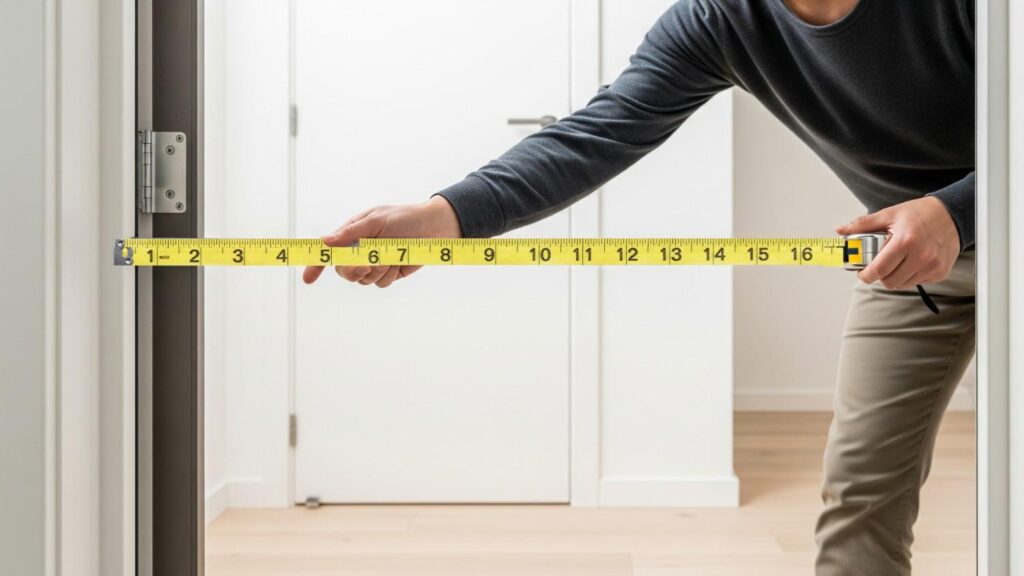
Start by taking accurate measurements of your entryway with a tape measure. Record both the length and width, as these numbers will guide your rug choice.
Knowing the exact size of your space helps you avoid rugs that are too small or oversized, making it easier to compare options.
Check Door Swing Clearance
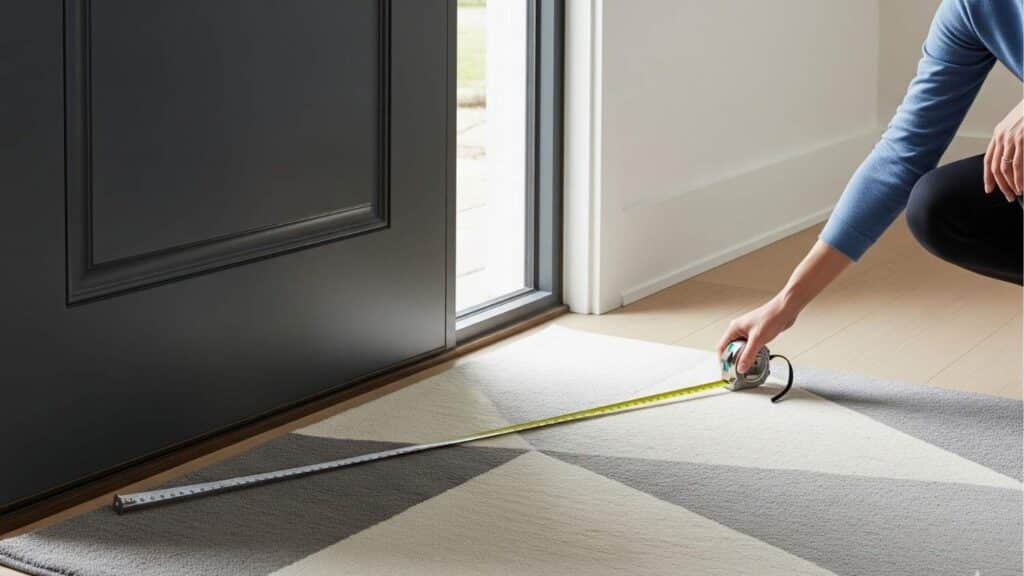
Always check how your doors open and close before buying a rug. Place the tape measure under the door swing to confirm the rug won’t bunch up or block movement.
Overlooking this step can create frustration later, so ensure your rug sits flat and works smoothly with your doors.
Leave a Floor Border
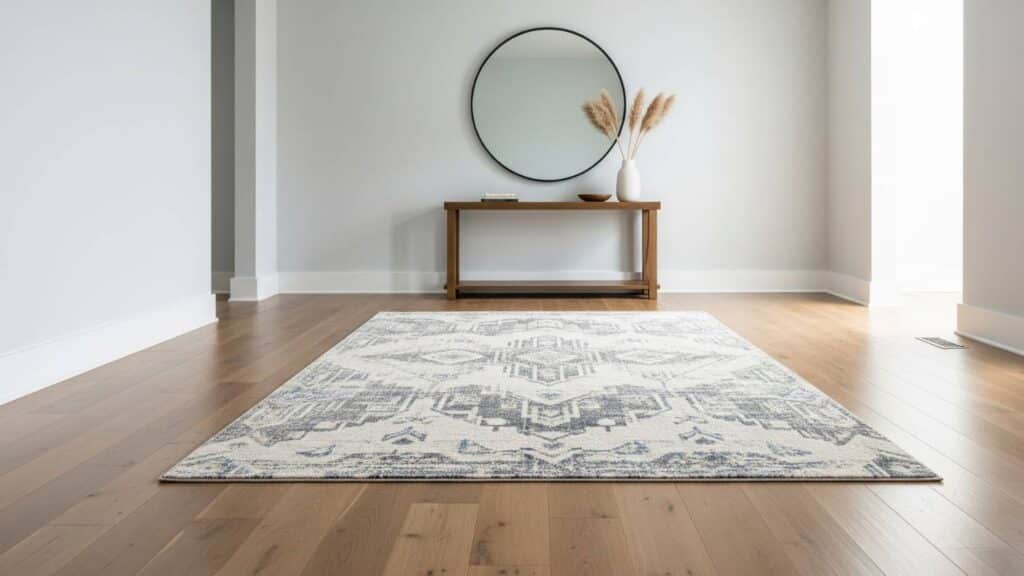
A good rule is to leave 6–12 inches of visible flooring around your rug. This border creates balance, prevents the rug from overpowering the entryway, and helps the space feel open.
Too little border can make your entry look crowded, while too much leaves the rug looking out of place.
Use Masking Tape to Test Placement
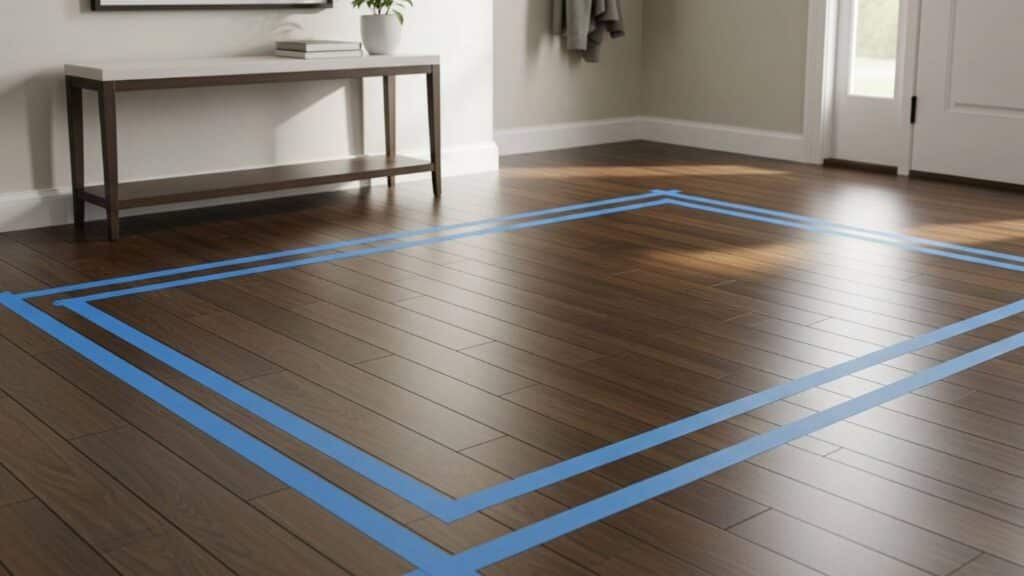
Before buying, mark the rug’s dimensions on the floor with masking tape. This quick test lets you visualize the rug’s fit and proportions within your space.
It’s the easiest way to see if the rug feels right, stays centered, and complements both the flooring and the entryway layout.
Entryway Rug Size Guide
Getting the size right is the first step to making your entryway look balanced. Here are the basics you need to know before choosing a rug:
1. Small Entryways
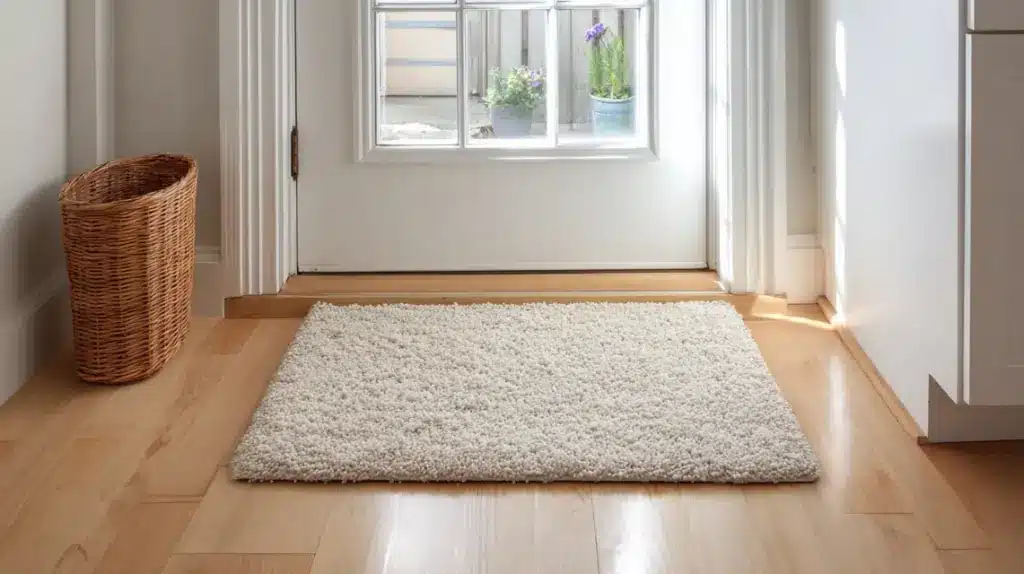
Small entryways work best with compact rugs that don’t overwhelm the space. A 2’x3′ or 3’x5′ rug adds just enough coverage to catch dirt while keeping the area open.
Place the rug so it sits centered with some visible floor around the edges. This avoids a cramped look while still protecting your flooring and making the entryway feel intentional.
2. Narrow Entryways
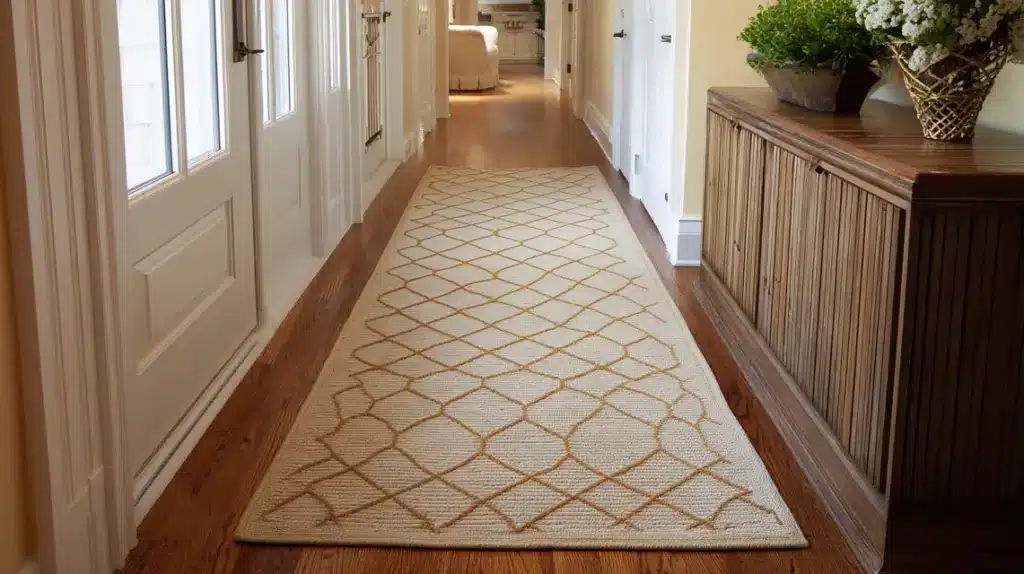
For a long time, hallway-like entries have been the most effective choice for runner rugs. Sizes like 2’x6′ or 3’x10′ elongate the entryway visually while guiding traffic flow. Runners also add function by collecting dirt and moisture along the main path.
When placing a runner, center it within the space and ensure there’s a clear border on both sides for a balanced look. This makes the area practical and polished at the same time.
3. Medium Entryways
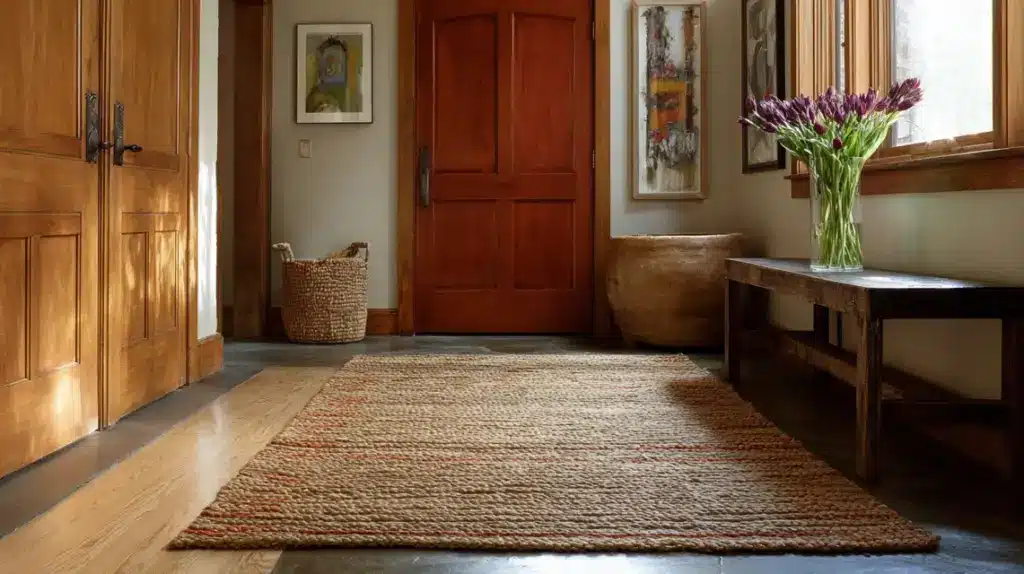
Medium-sized entryways need rugs that offer coverage without filling the entire space. Rugs around 4’x6′ or 5’x7′ provide a good balance between form and function.
These sizes are large enough to accommodate small furniture like a bench or console while still leaving visible floor edges.
Position the rug so it feels central, keeping proportions consistent to create a welcoming, structured entryway design that looks intentional.
4. Large Entryways
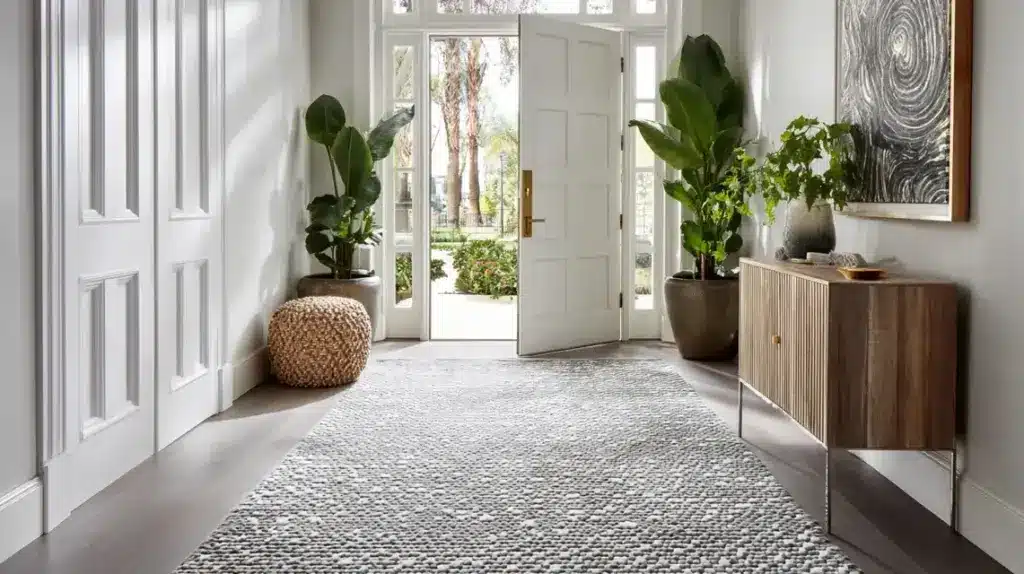
Large entryways benefit from rugs that make a statement while anchoring the space. Rugs sized 6’x9′ or 8’x10′ provide enough coverage to tie the entry together, especially if you have double furniture pieces or larger open areas.
Place the rug in the center and ensure it complements the room’s proportions. This approach prevents the entryway from feeling empty while adding comfort, structure, and durability in a busy traffic zone.
5. Double-Door Entryways
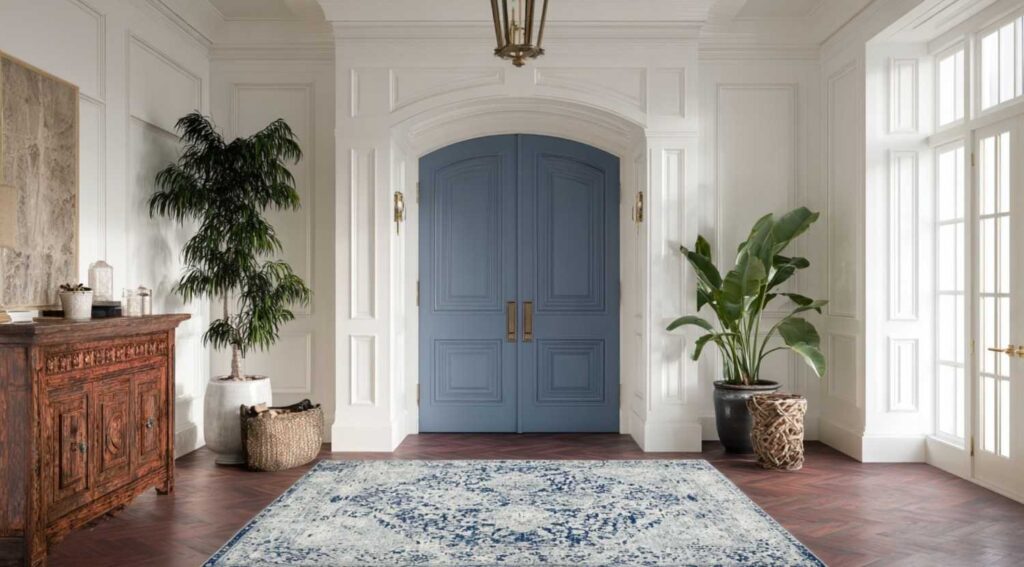
For wide double-door entries, rugs should span the full width to create balance and impact. Look for larger, rectangular rugs that cover the space without blocking door clearance.
A rug that stretches across both doors not only makes the area look cohesive but also helps catch more dirt from heavy traffic.
Centering the rug properly ensures symmetry, making your entryway feel polished, welcoming, and proportionally correct for its larger layout.
Quick Reference Table for Entryway Rug Size
| Entryway Type | Recommended Rug Size(s) | Best Placement Tip |
|---|---|---|
| Small Entryways | 2’x3′ or 3’x5′ | Center rug with a visible floor border to avoid a cramped look |
| Narrow Entryways | 2’x6′ or 3’x10′ Runner | Center runner with a clear border on both sides for balance |
| Medium Entryways | 4’x6′ or 5’x7′ | Leave edges visible while fitting small furniture, like a bench or console |
| Large Entryways | 6’x9′ or 8’x10′ | Anchor the space by centering the rug to prevent the area from feeling empty |
| Double-Door Entries | Wide rectangular rugs | Span the full width of both doors for symmetry, without blocking door clearance |
Rug Shapes and Style Options
Rugs come in different shapes and styles, and each one can change how your entryway feels. Here are some options worth thinking about:
1. Rectangular Rugs
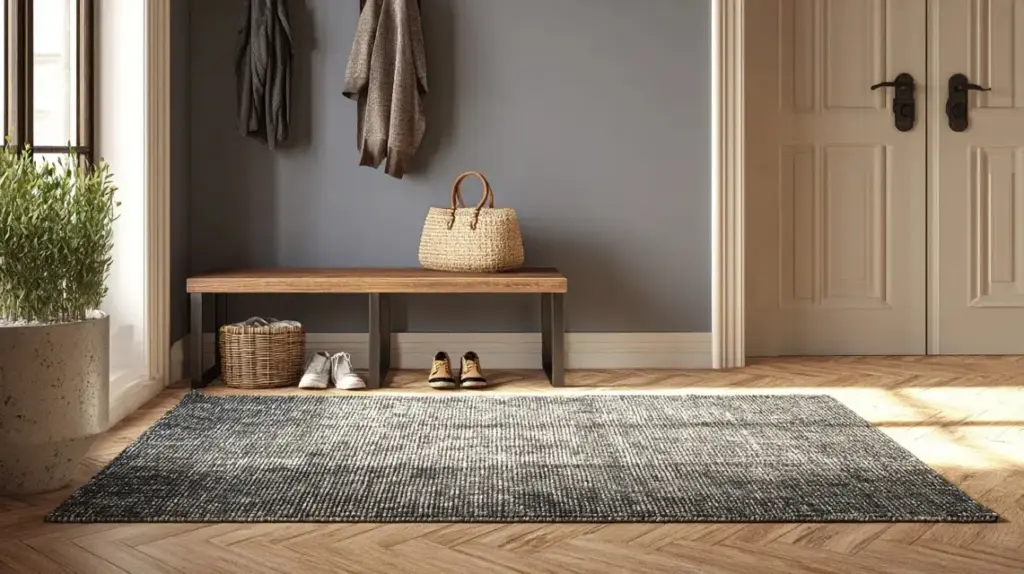
The most common choice, rectangular rugs fit easily into almost any entryway. They create clean lines and work well with both small and large layouts. A rectangular rug offers plenty of coverage while leaving a balanced border of flooring around the edges.
Best for: versatile layouts, traditional entries, areas needing more coverage.
Avoid if: your entryway is perfectly square or highly symmetrical, where other shapes may look more balanced.
2. Round Rugs
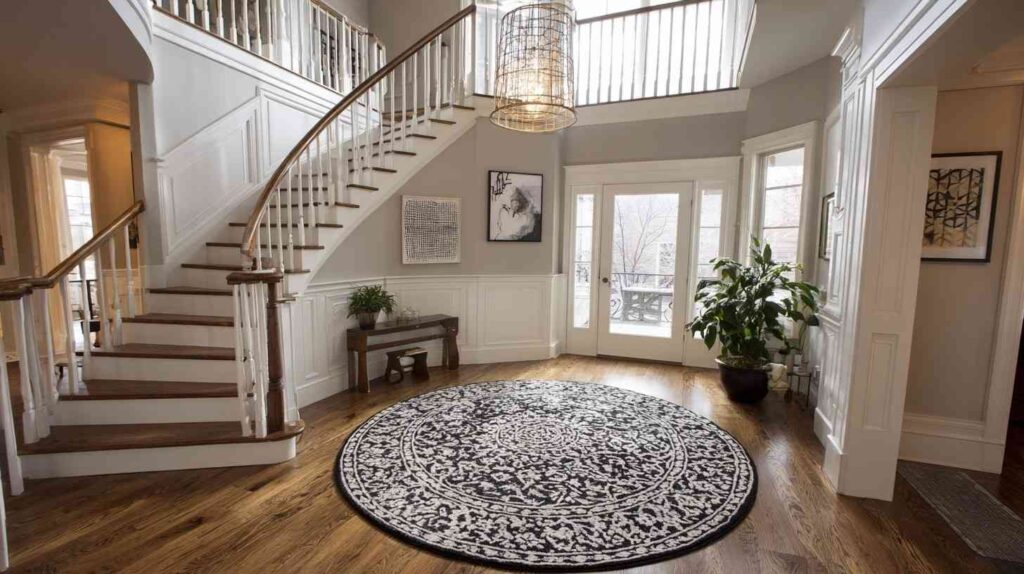
Round rugs soften the look of an entryway and add visual interest. They work especially well in symmetrical foyers or spaces with a centered light fixture. A round rug can break up sharp lines and create a more inviting flow as people step inside.
Best for: square foyers, centered layouts, and adding contrast to angular spaces.
Avoid if: your entryway is narrow or hallway-like, where a round rug may feel awkward and out of place.
3. Square Rugs
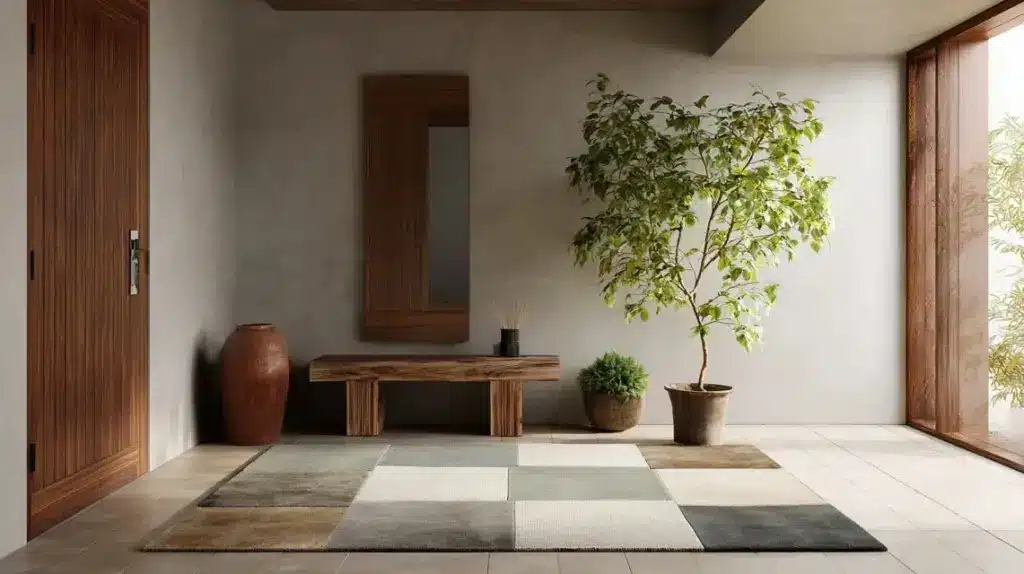
Square rugs mirror the shape of square entryways and help maintain proportion. They feel balanced in compact spaces and can anchor furniture like a bench or table. Square rugs are less common, but when used in the right layout, they add structure and harmony.
Best for: square layouts, compact foyers, entries with centered furniture.
Avoid if: your space is long, narrow, or irregularly shaped, as square rugs will highlight the imbalance.
4. Runners
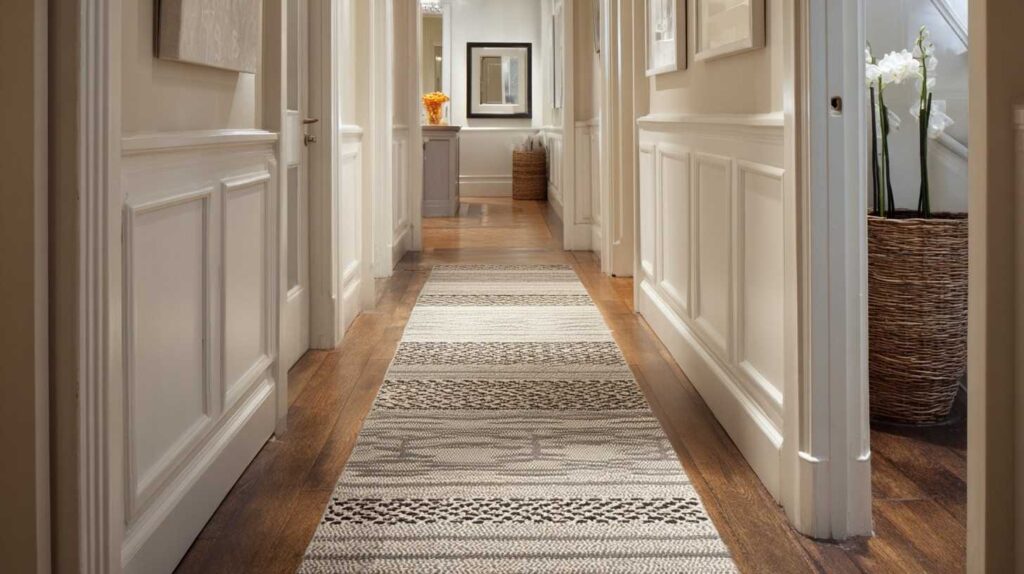
Runners are perfect for hall-like or narrow entryways. They draw the eye down the space, guiding foot traffic naturally. A runner also helps protect floors along the main walking path while keeping the layout simple and functional.
Best for: narrow or elongated entryways, guiding flow in high-traffic spaces.
Avoid if: your entryway is wide or square, since runners won’t provide enough coverage or balance.
Entryway Rug Ideas to Try
The right rug transforms your entry from plain to polished. Try these entryway rug ideas that balance style with function.
1. Layered Rugs for Texture
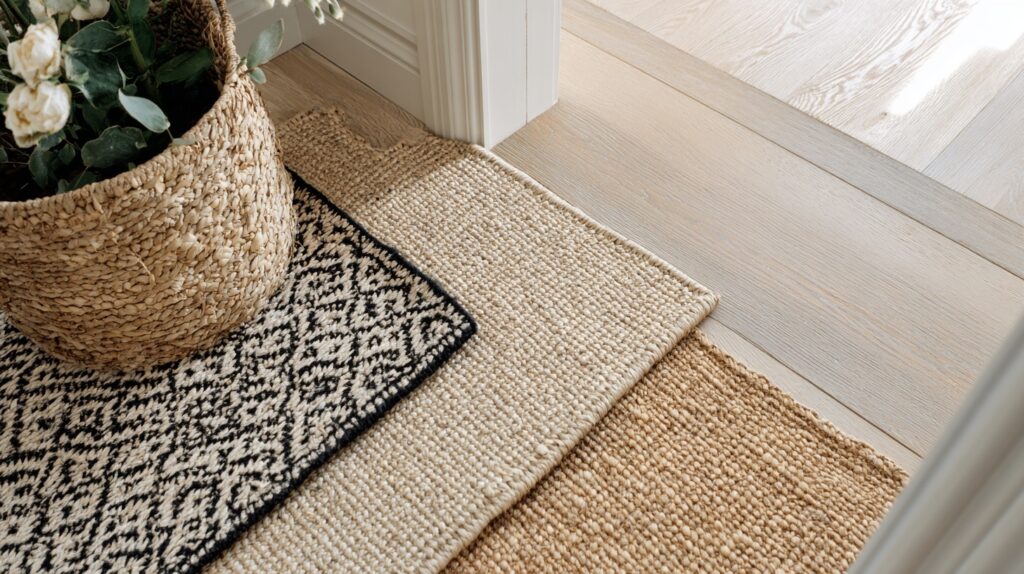
Place a small patterned rug over a neutral jute base. The layering adds depth, hides dirt, and makes your entry look inviting.
It’s also practical since you can swap the top rug seasonally while the base provides consistent protection and structure.
2. Bold Pattern to Make a Statement
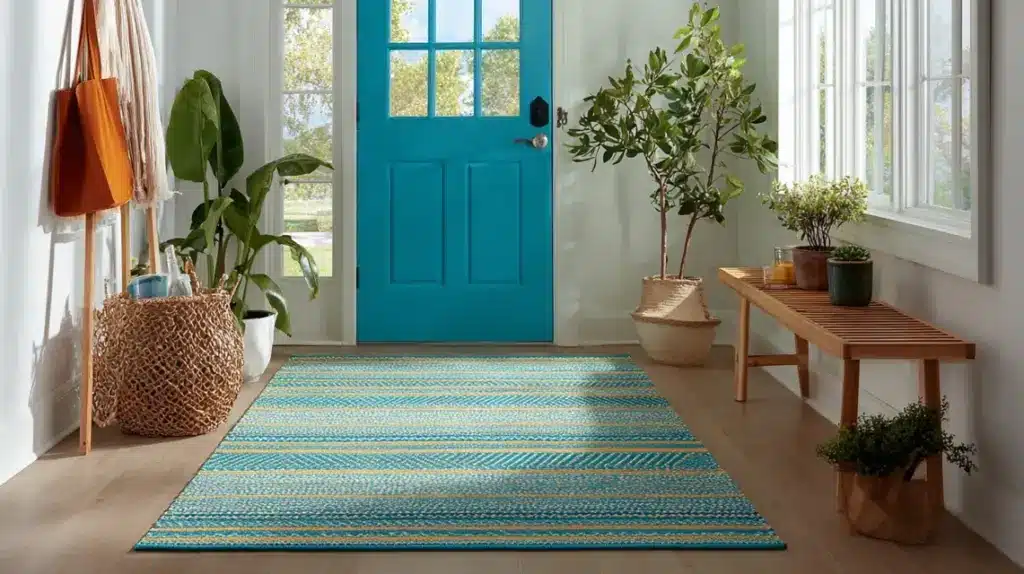
Choose a rug with stripes, geometrics, or bold colors. In a plain entry, it creates visual interest and sets the tone immediately.
Patterns also disguise footprints and stains, which makes them practical for busy households. A patterned rug can make even a small space feel stylish and intentional.
3. Neutral Rugs for Versatility
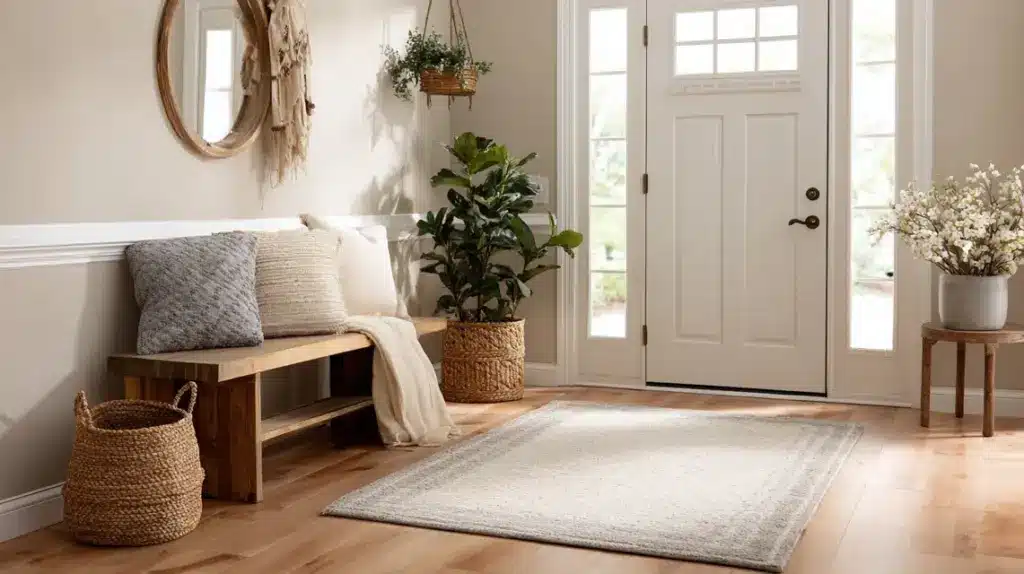
A solid beige, gray, or cream rug works well if your entryway already has colorful walls or furniture. Neutral tones keep the space calm and balanced while still protecting your floors.
They’re timeless, easy to match with seasonal décor, and create a welcoming backdrop without overwhelming the design.
4. Washable Rugs for Easy Care
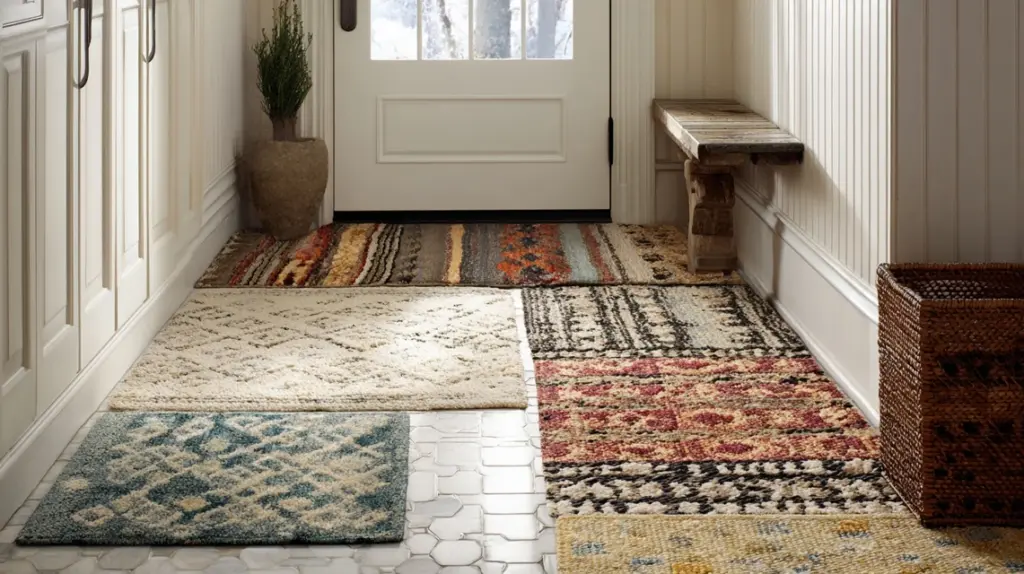
In high-traffic entries, a washable rug is the most practical choice. These rugs can handle mud, snow, and spills without stress. Just toss them in the washing machine when they get dirty.
They keep your entryway fresh year-round while still offering plenty of style and variety in colors and patterns.
5. Seasonal Rugs for Fresh Style
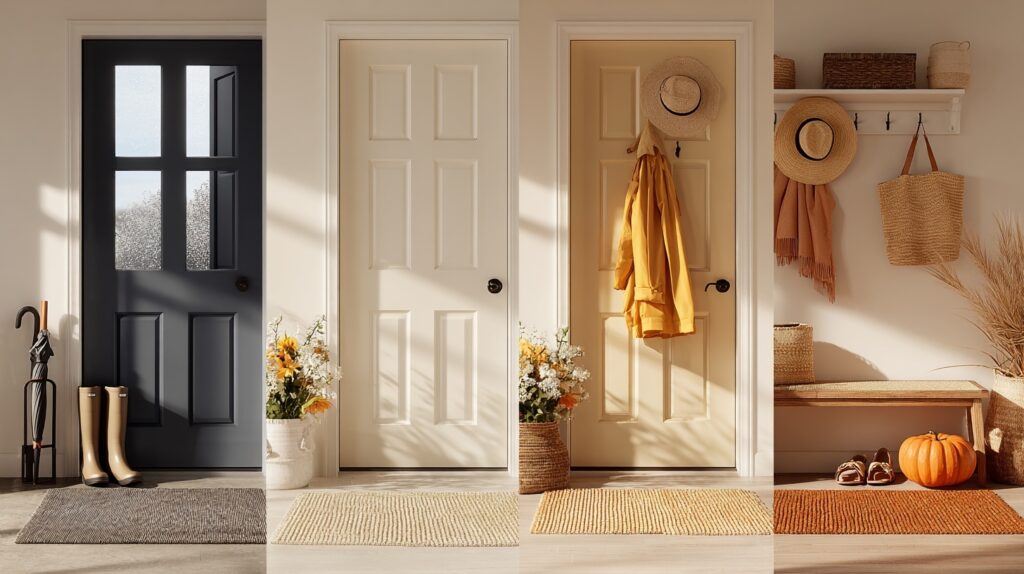
Rotate entryway rugs with the seasons. In winter, use durable indoor/outdoor options that handle snow, mud, and wet shoes.
In spring and summer, switch to lighter cotton or jute for added brightness and texture.
Seasonal swaps extend rug life, cut cleaning, and refresh the look. It’s a simple way to stay practical yet welcoming all year. For families and pets.
Rug Materials and Durability
The material of a rug decides how it feels, looks, and holds up over time. Here’s what to know about rug materials and durability before choosing one:
| Material | Key Features |
|---|---|
| Wool | Durable, warm, naturally resilient, and great for high-traffic entryways. |
| Jute/Natural Fibers | Eco-friendly, rustic texture adds natural style, but is less resistant to moisture. |
| Synthetic | Stain-resistant, affordable, and long-lasting, perfect for busy households. |
| Washable Rugs | Easy-care option, ideal for homes with kids, pets, or frequent messes. |
| Indoor/Outdoor Rugs | Designed for wet, muddy, or snowy conditions; durable and easy to clean. |
Selecting the right material ensures your rug remains practical and long-lasting, while also matching your lifestyle, climate, and overall design needs.
Practical Tips for Entryway Rugs
A rug can set the tone for your whole entryway, but only if you choose and use it the right way. Here are some simple tips to keep in mind:
- Always use rug pads for safety: Rug pads keep rugs from slipping, protect flooring, and add a little extra cushioning underfoot.
- Swap rugs seasonally (mud-resistant in winter, lighter in summer): Switching rugs helps manage dirt and wear while keeping the entryway fresh and practical throughout the year.
- Darker colors or patterns hide dirt: Choose designs that disguise footprints and stains, especially if your entryway sees heavy use or wet shoes.
- Vacuum regularly to prevent dirt buildup: Frequent vacuuming stops dirt from embedding in fibers and extends the life of the rug.
- Spot clean and deep clean as needed: Address spills right away and schedule deeper cleans to keep the rug fresh and hygienic.
- Rotate rugs to avoid uneven wear: Turning rugs every few months balances out foot traffic and prevents one side from wearing faster.
- Replace when rugs lose texture or grip: Once rugs flatten or slip easily, it’s time to replace them for safety and appearance.
- Allow furniture legs to sit partly on the rug: This anchors the rug visually, prevents movement, and connects furniture to the overall entryway layout.
Common Mistakes to Avoid with Entryway Rugs
Even a small slip in rug choice can throw off the look or function of your entryway. Here are a few mistakes to watch out for:
- Choosing rugs too small: A rug that’s undersized looks out of place and won’t protect enough of your flooring.
- Blocking door clearance: If the rug blocks or bunches under the door, it creates frustration and damages both the rug and the door.
- Skipping rug pads means a slipping hazard: Without a pad, rugs can slide around, creating safety risks and wearing down the flooring underneath.
- Ignoring proportions and entryway shape: Rugs that don’t match the layout or size of the space make the entryway look awkward and unfinished.
Conclusion
I believe the right entryway rug size can make your home feel more welcoming, practical, and easy to care for.
You’ve seen how to measure the space, match rug sizes to different layouts, and choose shapes and materials that hold up over time.
If you use these tips, you’ll protect your floors, guide foot traffic, and keep the entryway balanced.
For me, proportion and practicality are always the most important details.
If you’re thinking about more updates around your home, you can check out other decorating guides on the website. They can help you bring comfort and function into every room!














